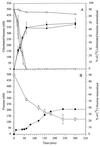Degradation of chlorobenzenes at nanomolar concentrations by Burkholderia sp. strain PS14 in liquid cultures and in soil
- PMID: 10347041
- PMCID: PMC91376
- DOI: 10.1128/AEM.65.6.2547-2552.1999
Degradation of chlorobenzenes at nanomolar concentrations by Burkholderia sp. strain PS14 in liquid cultures and in soil
Abstract
The utilization of 1,2,4,5-tetrachloro-, 1,2,4-trichloro-, the three isomeric dichlorobenzenes and fructose as the sole carbon and energy sources at nanomolar concentrations was studied in batch experiments with Burkholderia sp. strain PS14. In liquid culture, all chlorobenzenes were metabolized within 1 h from their initial concentration of 500 nM to below their detection limits of 0.5 nM for 1,2,4,5-tetrachloro- and 1,2,4-trichlorobenzene and 7.5 nM for the three dichlorobenzene isomers, with 63% mineralization of the tetra- and trichloroisomers. Fructose at the same initial concentration was, in contrast, metabolized over a 4-h incubation period down to a residual concentration of approximately 125 nM with 38% mineralization during this time. In soil microcosms, Burkholderia sp. strain PS14 metabolized tetrachlorobenzene present at 64.8 ppb and trichlorobenzene present at 54.4 ppb over a 72-h incubation period to below the detection limits of 0.108 and 0.09 ppb, respectively, with approximately 80% mineralization. A high sorptive capacity of Burkholderia sp. strain PS14 for 1,2,4, 5-tetrachlorobenzene was found at very low cell density. The results demonstrate that Burkholderia sp. strain PS14 exhibits a very high affinity for chlorobenzenes at nanomolar concentrations.
Figures




Similar articles
-
Multiphasic kinetics of transformation of 1,2,4-trichlorobenzene at nano- and micromolar concentrations by Burkholderia sp. strain PS14.Appl Environ Microbiol. 2001 Aug;67(8):3496-500. doi: 10.1128/AEM.67.8.3496-3500.2001. Appl Environ Microbiol. 2001. PMID: 11472925 Free PMC article.
-
Degradation of chlorobenzenes in soil slurry by a specialized organism.Appl Microbiol Biotechnol. 1994 Nov;42(2-3):415-20. doi: 10.1007/BF00902751. Appl Microbiol Biotechnol. 1994. PMID: 7765781
-
Genetic and biochemical characterization of the broad spectrum chlorobenzene dioxygenase from Burkholderia sp. strain PS12--dechlorination of 1,2,4,5-tetrachlorobenzene.Eur J Biochem. 1997 Jul 1;247(1):190-9. doi: 10.1111/j.1432-1033.1997.00190.x. Eur J Biochem. 1997. PMID: 9249026
-
Microbial degradation of 1,3-dichlorobenzene.Appl Environ Microbiol. 1986 Oct;52(4):677-80. doi: 10.1128/aem.52.4.677-680.1986. Appl Environ Microbiol. 1986. PMID: 3777923 Free PMC article.
-
Degradation of 1,2,4-trichloro- and 1,2,4,5-tetrachlorobenzene by pseudomonas strains.Appl Environ Microbiol. 1991 May;57(5):1430-40. doi: 10.1128/aem.57.5.1430-1440.1991. Appl Environ Microbiol. 1991. PMID: 16348484 Free PMC article.
Cited by
-
Sulfamethoxazole is Metabolized and Mineralized at Extremely Low Concentrations.Environ Sci Technol. 2024 Jun 4;58(22):9723-9730. doi: 10.1021/acs.est.4c02191. Epub 2024 May 18. Environ Sci Technol. 2024. PMID: 38761139 Free PMC article.
-
Biodegradation of linuron in a Phaseolus bioassay detected by chlorophyll fluorescence.New Phytol. 2002 Jun;154(3):821-829. doi: 10.1046/j.1469-8137.2002.00402.x. New Phytol. 2002. PMID: 33873450
-
Importance of soil organic matter for the diversity of microorganisms involved in the degradation of organic pollutants.ISME J. 2014 Jun;8(6):1289-300. doi: 10.1038/ismej.2013.233. Epub 2014 Jan 16. ISME J. 2014. PMID: 24430482 Free PMC article.
-
Thermodynamic analysis of biodegradation pathways.Biotechnol Bioeng. 2009 Jun 15;103(3):532-41. doi: 10.1002/bit.22285. Biotechnol Bioeng. 2009. PMID: 19288443 Free PMC article.
-
Degradation and mineralization of nanomolar concentrations of the herbicide dichlobenil and its persistent metabolite 2,6-dichlorobenzamide by Aminobacter spp. isolated from dichlobenil-treated soils.Appl Environ Microbiol. 2007 Jan;73(2):399-406. doi: 10.1128/AEM.01498-06. Epub 2006 Nov 17. Appl Environ Microbiol. 2007. PMID: 17114317 Free PMC article.
References
-
- Alexander M. The soil environment. In: Alexander M, editor. Introduction to soil microbiology. New York, N.Y: John Wiley & Sons; 1977. pp. 3–15.
-
- Alexander M. Biodegradation of organic chemicals. Environ Sci Technol. 1985;18:106–111. - PubMed
-
- Baughman G L, Paris D F. Microbial bioconcentration of organic pollutants from aquatic systems—a critical review. Crit Rev Microbiol. 1981;8:205–228. - PubMed
-
- Beck U. Nucleus-chlorinated aromatic hydrocarbons. In: Campbell F T, Pfefferkorn R, Rounsaville J F, editors. Ullmann’s encyclopedia of industrial chemistry. 5th ed. Weinheim, Germany: VCH Verlagsgesellschaft; 1986. pp. 330–355.
-
- Beil S, Happe B, Timmis K N, Pieper D H. Genetic and biochemical characterization of the broad spectrum chlorobenzene dioxygenase from Burkholderia sp. strain PS12. Dechlorination of 1,2,4,5-tetrachlorobenzene. Eur J Biochem. 1997;247:190–199. - PubMed
Publication types
MeSH terms
Substances
LinkOut - more resources
Full Text Sources

